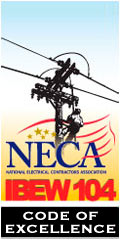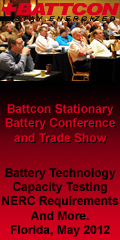
| Past Issues/Subscribe | Employment | neppa.org | Legislative Update | Advertise | April 2012 |

Grounding For Employee Protection
As I travel through the NEPPA service area and talk with many line crews all across New England I find that very few line crews are grounding de-energized electric distribution lines for employee protection. Utility crews more often choose to use the OSHA-approved method of treating the de-energized lines as though they were still energized. But with human nature being what it is, are those crews really treating those de-energized lines with the same respect they would have for energized lines? Are they working in the safest manner? OSHA believes that transmission and distribution systems are different from other energy sources found in general industry. The transmission and distribution lines and associated equipment are constructed outdoors and could possibly be re-energized by various means. An automobile accident near the jobsite could bring an energized conductor in contact with a de-energized line. A de-energized line could become energized by a lightning strike. It has been reported to me that one such event actually injured a lineworker in Maine a few years ago, which means that it can happen. Also, the "human error" factor will always be with us and lines that were supposed to be de-energized accidentally became re-energized. One of the advantages seen by lineworkers (removing their rubber gloves) of grounding overhead electric lines was taken away with the advent of the "Ground to Ground Rubber Glove Rule". This rule requires that appropriate insulated rubber gloves be worn whenever a lineworker ascends a pole or his bucket leaves the cradle and must remain on until the lineworker once again reaches the ground or cradles his bucket. With no real advantage and the fact that it often takes longer to install appropriate grounds for a job than it takes to finish the work, most line crews opt for treating the lines being worked as though they are still energized. It could be argued that the rubber insulated covering used every day by many crews is inadequate for working on or adjacent to energized lines. If that is indeed the case, what quality of cover up could be expected on lines that have been de-energized? Is there any advantage to grounding the de-energized lines that are being treated as energized? One obvious answer would be that the protective device would clear any previously de-energized line that should become re-energized as quickly as possible. Also, equal potential grounding has been shown to be the safest method to work on de-energized lines that may become re-energized by creating a "safe zone" of protection for the lineworker. I submit that if adequate rubber insulated covering is not employed by any crew working on a de-energized line and if the de-energized line is not given the exact same respect as an energized line, then that crew may be at risk of inadvertent electrical contact. That is something that no one wants. Perhaps we all need to re-examine the benefits of grounding de-energized electric lines. |




